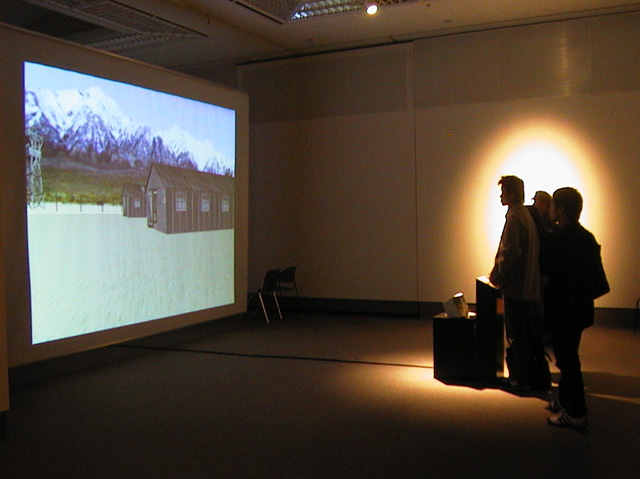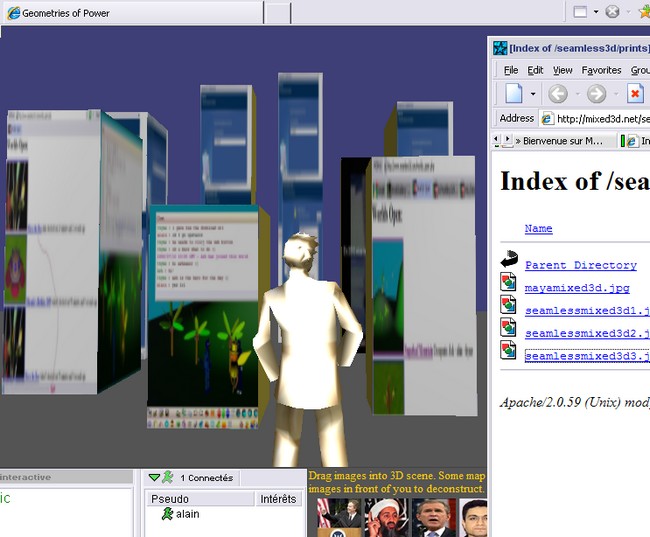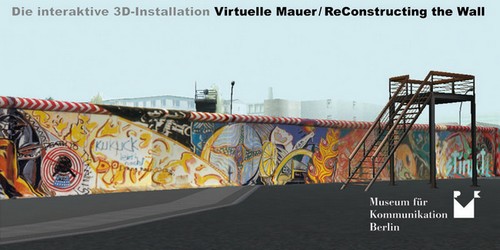1 - Quand avez-vous découvert le VRML ? Et pourquoi avez-vous décidé de l’utiliser ?
J’ai commencé à travailler avec la «réalité virtuelle» dans l’entreprise Worlds, Inc .
Ils avaient leur propre technologie multi-utilisateurs, et prétendaient être
les premiers à offrir sur un PC des images 3D en ligne multi-utilisateurs (”Worlds Chat”).
Ils m’ont engagée pour être la directrice artistique et productrice de «Starbright World»,
une communauté 3D en ligne pour des enfants gravement malade , proposée par le réalisateur Steven Spielberg
(voir mon site : http://www.mission-base.com/tamiko/starbright/ ).Quand j’ai quitté l’entreprise en 1996, je voulais développer mes propres œuvres d’art en utilisant ce type de VR sur PC.
Mon mari Peter Graf avait co-fondé l’entreprise VRML Blaxxun Interactive en 1995, et comme c’était un standard open (à la différence du monde, la technologie Inc »), cela semblait être une voie d’ avenir.
J’aime vraiment le fait que vous pouvez modifier vos mondes directement dans le code textuel vous-même .
On voit beaucoup plus clairement ce qui se passe, cela enlève un peu l’aspect « boîte noire» mystèrieuse .
2 - Vos oeuvres sont faites pour des expositions en public mais vous avez utilisé également des chats .
Par quoi avez-vous commencé ?
Mon premier travail a été le chat multi-utilisateurs du monde “Starbright World” décrit ci-dessus, un travail semi-commercial (à but non lucratif).
Mon premier travail artistique personnel a été «Beyond of Manzanar”
( http://www.mission-base.com/manzanar/ )
qui d’autre part a été une œuvre pour utilisateur unique , hors connexion et qui est montré comme une installation :
( http://www.mission-base.com/manzanar/description.html )
J’ai décidé d’aller vers cette forme en mode hors connexion, car je voulais que l’utilisateur fasse l’expérience
de sa rencontre avec le monde virtuel, et son contenu du monde virtuel.
J’avais passé beaucoup de temps en ligne sur les mondes en chat 3D ,
(World’s Chat, Cybertown sous blaxxun ) et remarqué que s’il y a un autre avatar là,
l’expérience devient inévitablement une conversation avec cet autre avatar.
Je voulais que les utilisateurs puissent se concentrer toutefois sur le contenu du monde virtuel que je leur présentais .
Un travail postérieur, qui utilise vraiment l’aspect en ligne multi-utilisateur est « Geometries of Power »
qui est sorti d’un atelier avec des étudiants de l’Université du Bauhaus à Weimar, en Allemagne.
( http://www.mission-base.com/geometries/ ) .
Dans cette pièce, vous pouvez faire glisser des images de la banque d’images
- mais aussi d’autres depuis un navigateur Internet -
dans le monde, et ils seront sur les bâtiments de la ville gratte-ciel concise .
Si vous avez un certain nombre de gens faisant cela en même temps,
ce que vous voyez en face de vous est une composition picturale en constante évolution que personne ne peut contrôler ! !
C’ est tout à fait exaltant et c’est un processus qui peut produire des images très intéressantes.
J’aime donc travailler selon ces deux voies, soit en ligne multi-utilisateurs soit hors ligne avec un utilisateur unique,
mais je pense que dans chaque cas, on doit réfléchir à l’objectif visé et à l’ effet que l’on souhaite obtenir , et choisir en conséquence.
Q3-Comment êtes-vous venu à la 3D comme un moyen d’expression? Qu’utilisez-vous comme programmes , moyens de programmation etc ?
J’avais déjà travaillé avec la vidéo, et pour des installations vidéo. J’ai désiré travailler de plus en plus avec l’espace.
Mais à cette époque, au milieu des années 1990, il était très cher d’avoir un studio plein de moniteurs
et de moyens sonores et projecteurs.
Donc j’ai d’abord pensé que je pourrais utiliser la 3D pour faire des maquettes de mes installations vidéo.
Puis je me suis davantage intéressé à faire des
mondes virtuels comme un art en soi, et j’en ai fait depuis 1995.
Q4 - Avez-vous essayé autre chose que le VRML, pour la 3D? Ou bien le ferez-vous ?
J’ai déjà mentionné Worlds, Inc ci-dessus. Je regarde maintenant Unity3D
pour un usage en particulier dans les projets que je pourrais faire en Inde.
Depuis que Unity3D a une version qui est libre, c’ est intéressant pour une utilisation dans
des projets à but non lucratif dans les pays en développement.
Q5 - Pensez vous que vous pourriez à nouveau mettre l’une de vos œuvres entièrement en ligne pour la monter au plus grand nombre sur le Web ?
Cela dépend réellement du projet. Mes grands mondes virtuels sont faits pour être vus en taille réelle et beaucoup d’entre eux perdraient vraiment en qualité, je crois, si on les regardait sur un petit écran. De plus ils tiennent leur vie de la souplesse des transitions et du grand nombre d’objets et de textures et cela souffrirait probablement beaucoup des lenteurs de chargement sur le net.
J’essaie au moins de mettre une petite partie du monde virtuel en ligne pour que ceux qui le veulent puissent découvrir un peu le monde virtuel interactif.
Des œuvres comme « géométries » qui sont conçues spécifiquement pour une communauté multiutilisateurs peuvent bien sur être montrées en ligne.
Q6 – Avez-vous d’autres nouveaux projets en 3d ?
En ce moment je suis entre plusieurs projets, j’étudie de nouvelles technologies (comme Blender 3D) , je cherche des subventions , visite des amis, je vais à des expositions, et je profite de la vie .. en réfléchissant à la direction dans laquelle je souhaite aller. Rien de très précis encore pour le moment !
Q7 – Que pensez vous de la 3d dans le futur ? et à propos du vrml maintenant ?
Je trouve que c’est réellement dommage que le vrml a été déclaré « mort » en 1997 et ne se soit jamais vraiment remis de cette sentence.
La 3d semble de plus en plus utilisée et il est clair qu’elle ne va pas disparaitre maintenant mais je ne sais pas combien de personnes dans le monde utilisent encor le vrml ? Je me présente parfois moi-même comme « la dernière artiste en vrml au monde »
………………………………………….
Q1: When did you discover wrml? And why you decided to use it?
—————————————————————
I first started working with “virtual reality” at the company
Worlds, Inc. They had their own multi-user technology, and claim to be
the first ones to have had a PC based 3D online multi-user system
(”Worlds Chat”). They hired me to be the creative director and producer
of “Starbright World,” an online 3D community for seriously ill
children, proposed by the film director Steven Spielberg (see my website
portfolio: http://www.mission-base.com/tamiko/starbright/).
When I left the company in 1996, I wanted to develop my own artworks
using this sort of PC-based VR. My husband Peter Graf had co-founded the
VRML company blaxxun Interactive back in 1995, and since it was an open
standard (unlike World, Inc.’s technology), it seemed to be the way to
go and the ‘wave of the future.’ I really like the fact that you can
edit your worlds directly in the text yourself - it makes it much more
clear what is going on, takes out the ‘black-box’ mystery a little bit.
Q2: Main of your work is made for public exhibitions but you tried some
chats too. What did you made first ?
———————————————————————–
My first work was the multi-user chat world “Starbright World”
described above, a semi-commercial (non-profit) work. My first personal
artwork was “Beyond Manzanar” (http://www.mission-base.com/manzanar/)
which on the other hand was an offline single user piece that is shown
as an installation: (http://www.mission-base.com/manzanar/description.html)
I decided to go for this offline form because I wanted the user
experience to be an encounter between the user and the virtual world,
and the content of the virtual world. I had spent a lot of time online
in 3D chat worlds (World’s Chat, blaxxun’s Cybertown) and noticed that
if there is another avatar there, the experience inevitably becomes a
conversation with that other avatar. I wanted the users to focus however
on the content of the virtual world I was presenting them with.
A later work that really uses the online multi-user aspect fully is
the piece “Geometries of Power,” which came out of a workshop with
students of the Bauhaus University in Weimar, Germany.
(http://www.mission-base.com/geometries/) In this piece, you can drag
images from the image bank - but also just out of an Internet browser -
into the world, and they will map onto the “buildings” in the very
small, abstracted high-rise city. If you have a small crowd of people
all doing this at the same time, what you see is a constantly changing
pictorial composition in front of you - and no one is in control at all!
It is quite exhilarating and a very interesting process which can
produce some very interesting images.
So I like working in both media, i.e. online multi-user and offline
single user, but I think in each case one must think of the goal and the
effect one wishes to have, and choose accordingly.
Q3- How did you come to 3d as a way of expression ? What did you use for
that ? softwares , coding , etc
———————————————————————–
I had been working with video, and video installations. I found
myself wanting to work more and more with space. But at that time, in
the mid-1990s, it was very expensive to have a roomfull of monitors and
tapeplayers and projectors. So I first thought that I could use 3D to
mock-up my video installations. Then I got more interested in making
virtual worlds as an artform in itself, and have been doing this since 1995.
Q4 - Did you tried something else than vrml , for 3D ? Or will do ?
———————————————————————
I already mentioned Worlds, Inc. above. I am looking at unity3D
right now for use especially in projects that I might do in India. Since
unity3D has a version that is free, it is attractive for use in
non-profit projects in developing countries.
Q5 - Do you think you could put some of your work again entirely online
to show them to a larger audience on the web ?
————————————————————————
It will continue to really depend on the project. My large virtual
worlds are meant to be seen life-sized, and some of them really lose
quality, I feel, if you look at them on a small monitor. Also, most of
them really live from seamless transitions of often large amounts of
geometries and textures, which might suffer badly when viewed over the
Internet, with lags in downloads. I try to at least put a small piece of
the virtual world online, so those who wish to can encounter a bit of
the interactive virtual world.
Works like “Geometries” which are designed specifically for a
multi-user community must of course be shown online.
Q6 - Do you have other new projects in 3d ?
——————————————–
At the moment I am between projects, checking out new technologies
(like Blender3D) and applying for grants, and visiting friends, and
going to art exhibitions, and enjoying life … and thinking about what
direction I want to go from here. Nothings clear right now though!
Q7 - What do you think about the 3d in the future ?
and what about vrml now ?
—————————————————-
I find it a real pity that VRML had been declared “dead” back in 1997,
and never really recovered from this pronouncement. 3D seems to be more
and more in use, and it is clear it will not disappear now. But I don’t
know how many people world-wide are still using VRML? Sometimes I call
myself “the last VRML artist in the world!”





















